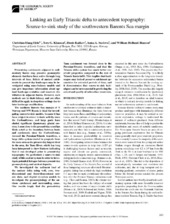| dc.contributor.author | Eide, Christian Haug | |
| dc.contributor.author | Klausen, Tore Grane | |
| dc.contributor.author | Katkov, Denis | |
| dc.contributor.author | Suslova, Anna | |
| dc.contributor.author | Helland-Hansen, William | |
| dc.date.accessioned | 2018-04-25T11:40:47Z | |
| dc.date.available | 2018-04-25T11:40:47Z | |
| dc.date.issued | 2018-01 | |
| dc.Published | Eide CH, Klausen TGK, Katkov, Suslova A, Helland-Hansen W. Linking an Early Triassic delta to antecedent topography: Source-to-sink study of the southwestern Barents Sea margin . Geological Society of America Bulletin. 2018;130:263-283 | eng |
| dc.identifier.issn | 0016-7606 | en_US |
| dc.identifier.issn | 1943-2674 | en_US |
| dc.identifier.uri | https://hdl.handle.net/1956/17656 | |
| dc.description.abstract | Present-day catchments adjacent to sedimentary basins may preserve geomorphic elements that have been active through long intervals of time. Relicts of ancient catchments in present-day landscapes may be investigated using mass-balance models and can give important information about upland landscape evolution and reservoir distribution in adjacent basins. However, such methods are in their infancy and are often difficult to apply in deep-time settings due to later landscape modification. The southern Barents Sea margin of N Norway and NW Russia is ideal for investigating source-to-sink models, because it has been subject to minor tectonic activity since the Carboniferous, and large parts have eluded significant Quaternary glacial erosion. A zone close to the present-day coast has likely acted as the boundary between basin and catchments since the Carboniferous. Around the Permian-Triassic transition, a large delta system started to prograde from the same area as the present-day largest river in the area, the Tana River, which has long been interpreted to show features indicating that it was developed prior to present-day topography. We performed a source-to-sink study of this ancient system in order to investigate potential linkages between present-day geomorphology and ancient deposits. We investigated the sediment load of the ancient delta using well, core, two-dimensional and three-dimensional seismic data, and digital elevation models to investigate the geomorphology of the onshore catchment and surrounding areas. Our results imply that the present-day Tana catchment was formed close to the Permian-Triassic transition, and that the Triassic delta system has much better reservoir properties compared to the rest of Triassic basin infill. This implies that landscapes may indeed preserve catchment geometries for extended periods of time, and it demonstrates that source-to-sink techniques can be instrumental in predicting the extent and quality of subsurface reservoirs. | en_US |
| dc.language.iso | eng | eng |
| dc.publisher | The Geological Society of America | en_US |
| dc.rights | Attribution CC BY | eng |
| dc.rights.uri | http://creativecommons.org/licenses/by/4.0 | eng |
| dc.title | Linking an Early Triassic delta to antecedent topography: Source-to-sink study of the southwestern Barents Sea margin | en_US |
| dc.type | Peer reviewed | |
| dc.type | Journal article | |
| dc.date.updated | 2018-01-29T08:16:25Z | |
| dc.description.version | publishedVersion | en_US |
| dc.rights.holder | Copyright 2017 The Author(s) | en_US |
| dc.identifier.doi | https://doi.org/10.1130/b31639.1 | |
| dc.identifier.cristin | 1489023 | |
| dc.source.journal | Geological Society of America Bulletin | |
| dc.relation.project | Norges forskningsråd: 234152 | |

